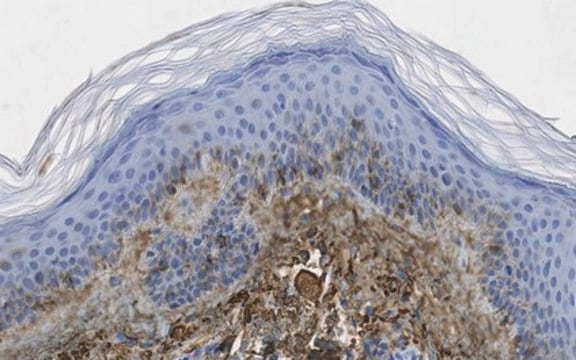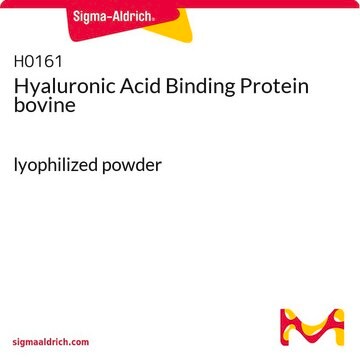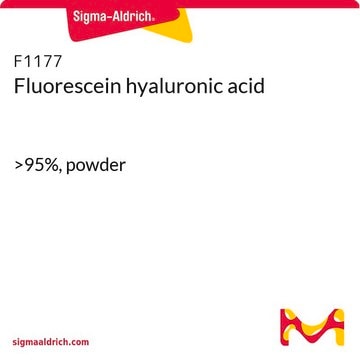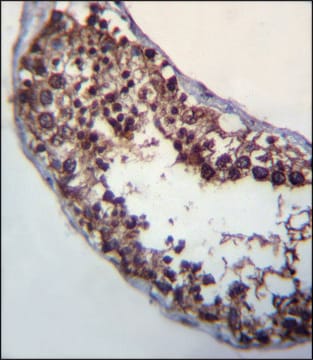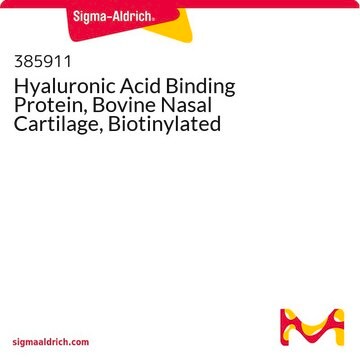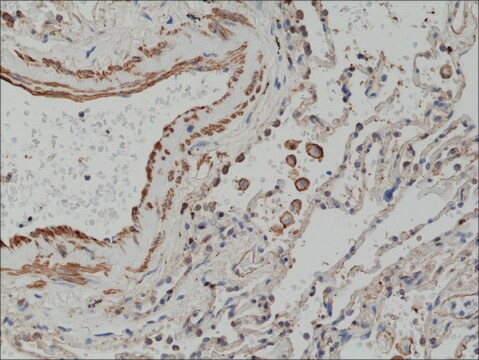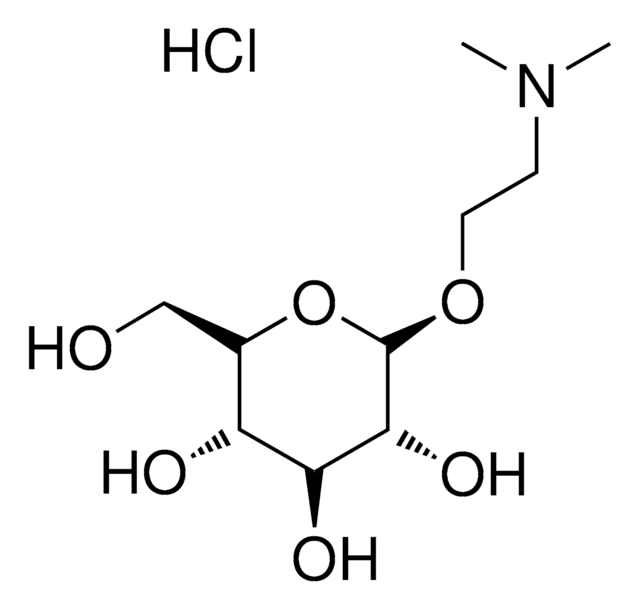MAB2022
Anti-Keratan Sulfate Antibody, clone EFG-11
ascites fluid, clone EFG-11, Chemicon®
Sign Into View Organizational & Contract Pricing
All Photos(1)
About This Item
UNSPSC Code:
12352203
eCl@ss:
32160702
NACRES:
NA.41
Recommended Products
biological source
mouse
Quality Level
antibody form
ascites fluid
clone
EFG-11, monoclonal
species reactivity
sheep, bovine, pig, canine, mouse, human
manufacturer/tradename
Chemicon®
technique(s)
ELISA: suitable
radioimmunoassay: suitable
western blot: suitable
isotype
IgG2b
NCBI accession no.
UniProt accession no.
shipped in
dry ice
target post-translational modification
unmodified
Gene Information
human ... LUM(4060)
Specificity
Recognizes 2-3 disaccharide units on both skeletal (type II) and corneal (type I) keratan sulfate chains either in isolated or proteoglycan-bound form. The epitope is resistant to proteolytic or alkaline cleavages and partially sensitive to keratanase or other endo-B-galactosidase treatment.
Immunogen
Human articular cartilage proteoglycan digested with chondroitinase ABC.
Application
Anti-Keratan Sulfate Antibody, clone EFG-11 is an antibody against Keratan Sulfate for use in ELISA, RIA & WB.
Research Category
Cell Structure
Cell Structure
Research Sub Category
Cytokeratins
Cytokeratins
Western blot at 1:1000 - 1:4000
ELISA at 1:5,000-1:20,000
RIA at 1:30,000-1:500,000
May be used in a competitive inhibition assay to measure keratan sulfate levels.
ELISA at 1:5,000-1:20,000
RIA at 1:30,000-1:500,000
May be used in a competitive inhibition assay to measure keratan sulfate levels.
Physical form
Ascites liquid, no preservative.
Storage and Stability
Maintain at -20°C in convenient aliquots for up to 12 months. Avoid repeated freeze/thaw cycles.
Legal Information
CHEMICON is a registered trademark of Merck KGaA, Darmstadt, Germany
Disclaimer
Unless otherwise stated in our catalog or other company documentation accompanying the product(s), our products are intended for research use only and are not to be used for any other purpose, which includes but is not limited to, unauthorized commercial uses, in vitro diagnostic uses, ex vivo or in vivo therapeutic uses or any type of consumption or application to humans or animals.
Storage Class Code
10 - Combustible liquids
WGK
WGK 1
Flash Point(F)
Not applicable
Flash Point(C)
Not applicable
Certificates of Analysis (COA)
Search for Certificates of Analysis (COA) by entering the products Lot/Batch Number. Lot and Batch Numbers can be found on a product’s label following the words ‘Lot’ or ‘Batch’.
Already Own This Product?
Find documentation for the products that you have recently purchased in the Document Library.
G Cs-Szabó et al.
Arthritis and rheumatism, 38(5), 660-668 (1995-05-01)
To identify characteristic changes in large aggregating (aggrecan) and small proteoglycan (PG) populations in articular cartilages during osteoarthritis (OA) and rheumatoid arthritis (RA). Aggrecan populations in guanidine extracts of femoral condylar cartilages of 46 OA and 8 RA patients who
Monoclonal antibodies to different protein-related epitopes of human articular cartilage proteoglycans.
Glant, T T, et al.
The Biochemical Journal, 234, 31-41 (1986)
Liping Yang et al.
Journal of the Association for Research in Otolaryngology : JARO, 19(4), 353-362 (2018-04-25)
Otoconia-related vertigo and balance deficits, particularly benign paroxysmal positional vertigo (BPPV), are common. Our recent studies in humans show that, while BPPV prevalence greatly increases with age in both genders, peri-menopausal women are especially susceptible. In the present study, we
P J Roughley et al.
Pediatric research, 22(4), 409-413 (1987-10-01)
Proteoglycan was isolated from the epiphyseal cartilage of the knee joint from human fetuses, ranging in age from 11 to 19 wk of gestation. The content of proteoglycan, per wet weight of cartilage, increased with gestational age, and structural changes
Jesús-José Ferre-Fernández et al.
Human genomics, 16(1), 49-49 (2022-10-27)
FOXC1 encodes a forkhead-domain transcription factor associated with several ocular disorders. Correct FOXC1 dosage is critical to normal development, yet the mechanisms controlling its expression remain unknown. Together with FOXQ1 and FOXF2, FOXC1 is part of a cluster of FOX
Our team of scientists has experience in all areas of research including Life Science, Material Science, Chemical Synthesis, Chromatography, Analytical and many others.
Contact Technical Service